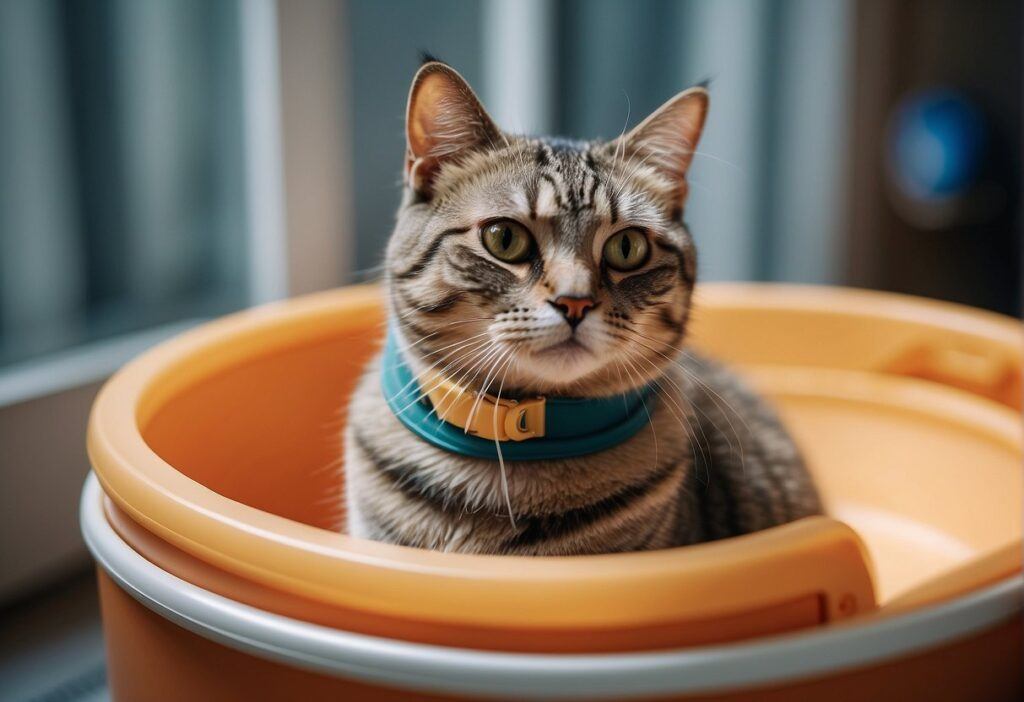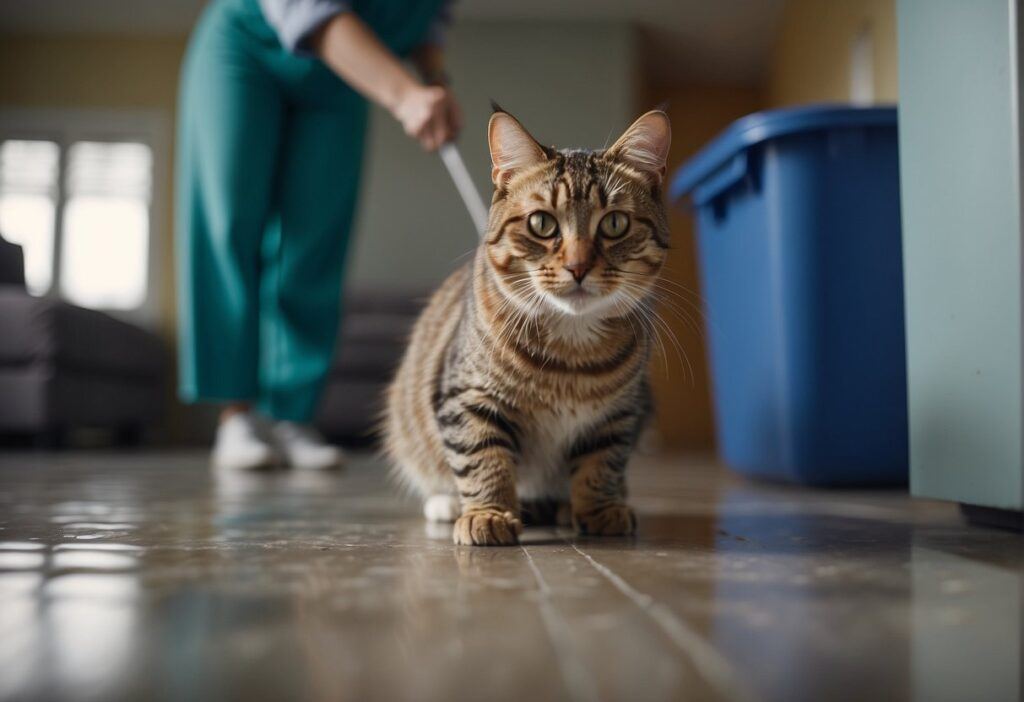When a cat undergoes surgery, particularly involving the urinary bladder, their post-operative behavior, including litter box habits, can change significantly.
This article provides essential insights into managing these adjustments, emphasizing the importance of providing easy access to a suitable litter box.
For cats recovering from surgeries with visible stitches, using a large carrier or a covered box lined with soft, unscented litter and avoiding harsh plastic liners can prevent irritation and support healing.
Maintaining cleanliness with an enzymatic cleaner helps prevent the development of antibiotic resistance by effectively breaking down odors and stains without harming your cat’s sensitive areas.
It’s also crucial to address the psychological aspects of recovery.
Implementing anti-anxiety medication, as prescribed by a veterinarian, can mitigate stress-induced avoidance of the litter box.
This comprehensive guide aims to support pet owners through recovery, ensuring a smooth transition back to normalcy for their beloved feline companions.
Understanding Post-Surgery Behavior in Cats

After surgery, cats may exhibit atypical behavior due to discomfort or confusion, but insight into these changes helps in their recovery.
Assessing Cat’s Behavior and Medical Issues
Post-operative behavior in cats can vary, often due to the stress of surgery and the discomfort it may bring.
Monitoring the cat’s activity levels, appetite, and litter box use is critical.
Lethargy or aggression can be signs of pain or medical issues. Any deviation from normal behavior warrants closer examination, particularly concerning the cat’s surgical site.
- Lethargy: May indicate pain or infection
- Aggression: Can be a defensive response due to discomfort
Evaluating Pain Medication and Comfort
Pain management is a cornerstone of post-surgery care.
Veterinarians commonly prescribe pain medication to minimize discomfort, which can subsequently alter a cat’s behavior.
Drowsiness or decreased mobility may be side effects of these medications.
Ensuring a comfortable, quiet resting area away from high traffic and noise helps the cat recover.
Pain Medication Side Effects:
- Drowsiness
- Decreased mobility
- Changes in litter box habits
Identifying Signs of Healing Process and Complications
Monitoring the healing process is vital for a speedy recovery.
Regular inspection of the incision site for signs such as redness, discharge, or excessive swelling helps detect complications early.
Signs that the cat is healing well include reduced swelling, the incision appearing clean, and the cat gradually resuming normal behavior.
Healing Indicators:
- Reduction in swelling
- Clean incision site
- Resumption of normal activities
Complication Signs:
- Excessive Swelling: May signify infection
- Discharge: Could indicate an open wound or infection
- Behavioral Changes: Such as not using the litter box, which could point to pain or complications
Managing Litter Box Issues After Surgery

Post-surgical care, including managing litter box habits, is crucial for a cat’s recovery. Appropriate litter and box placement can help a cat comfortably readjust to using the litter tray.
Choosing the Right Litter Type
Selecting the ideal litter type is key for a cat recuperating from surgery.
Paper-based litter is often recommended due to its soft texture, which is gentler on incisions. A fine-grained, unscented litter can also be beneficial as it is less likely to irritate wounds.
- Recommended: Paper-based, fine-grained, unscented litter
- Avoid: Coarse, scented, or clumping litter that may stick to surgical sites
Litter Box Accessibility and Placement
Ensuring litter box accessibility is essential for a cat who has just undergone surgery.
The litter box should be placed in a quiet, easily accessible location so the cat does not need to climb or jump to access it, which may hinder recovery.
- Height: No higher than the cat’s leg length
- Number of Boxes: One per cat, plus one extra, to prevent overuse and maintain a clean litter box
- Placement: Secure, stable location; no stairs or obstacles near the box
Addressing Common Post-Surgical Complications

After surgery, cats may experience various complications affecting their recovery process. Understanding and addressing these complications is vital to ensure a prompt return to health.
Urinary Issues and Kidney Health
Urinary tract infections (UTIs) and kidney disease can arise as post-surgical complications, potentially causing a cat to avoid the litter box.
These complications might be due to various factors, including stress, reduced mobility, or changes in urinary habits post-operation.
Cats with feline lower urinary tract disease (FLUTD) are particularly at risk of developing a urinary blockage after surgery. Monitoring the cat closely for signs of difficulty urinating is crucial.
- Urinary Tract Infections are characterized by symptoms such as frequent urination, discomfort, and even blood in the urine. Immediate medical advice is recommended.
- Kidney Health: Should a cat show decreased urination or other signs of kidney problems, this warrants prompt veterinary attention to prevent progression.
Infection Prevention and Wound Care
Infection at the surgical site can be a serious issue, so proper wound care is critical.
It includes monitoring for signs of infection around skin sutures or dissolvable stitches and ensuring the environment is clean to minimize the risk of accidental injury to the wound area.
- Surgical Site Care: Regular assessment for redness, swelling, or discharge. Maintain cleanliness and follow the veterinarian’s guidelines on wound management.
- Infection Prevention: Proactive measures, such as keeping the cat’s living area clean and avoiding activities that could stress the wound, are essential to prevent infection.
Helpful Aids for Recovery at Home

After a surgical procedure, it’s critical to adjust your home environment to support your cat’s healing process.
Containing your pet in a controlled space and providing comfort and enrichment can significantly aid their recovery.
Containing Cats Post-Surgery
Containment is often necessary to keep a recovering cat safe.
A dog crate or a small room such as a bathroom can serve as a secure recovery area.
Ensure it’s a calm space, away from the household’s hustle and bustle.
It is important to restrict your cat’s movement, particularly for surgeries after which jumping or stretching can disrupt healing. A modified environment might look as follows:
- Dog Crate: Equipped with a soft bed and space for food and water.
- Small Room: Removing hazardous objects and providing a comfortable resting space is key.
Enrichment and Comfort Solutions
Surgical recovery can be stressful for cats, requiring extra comfort and care.
Elizabethan collars or recovery suits prevent cats from licking or biting their wounds.
While uncomfortable, they are critical for preventing infection and ensuring proper healing. To improve the experience, consider the following:
- Elizabethan Collar: Introduce it gradually and monitor your cat’s ability to eat and drink.
- Recovery Suit: A comfortable alternative that allows more freedom of movement.
To promote a sense of calm, utilities like pheromone diffusers can be used to ease anxiety naturally. Here are additional details:
- Pheromone Diffusers: Plug near the resting area to create a calming atmosphere.
Providing a cat tree with low platforms can enable your cat to enjoy vertical space without risking injury.
Finally, always be prepared to consult with an animal hospital if you have concerns about your cat’s recovery progress or behavior.
Owner’s Guide to Post-Operative Care

Post-surgery, cats may temporarily reject their litter boxes. Proper medication administration and watchful recovery monitoring are imperative for a smooth transition to routine activities.
Administering Medication and Special Diets
Cats require prescribed medications to prevent infections and manage pain after surgery.
Oral medications might need to be given directly or mixed with food.
- Ensure all prescribed medications are given as per the vet’s instructions.
- Never offer over-the-counter medications unless advised by a veterinarian.
- Follow any special diets recommended to aid recovery.
- Keep a regular schedule for medications to maintain consistent levels in the bloodstream.
Monitoring Recovery and When to Seek Help
Observing a cat’s behavior post-surgery is crucial to healing well.
- First step: Look for signs of distress or abnormal behaviors, including avoidance of the litter box.
- Should symptoms like lethargy, excessive sleep, refusal to eat or drink, or signs of pain persist, it may signify a medical emergency.
- A deviation from detailed instructions provided by the vet on post-operative care should prompt contacting them.
- Monitor the surgical site for signs of infection or poor healing and, if necessary, complete the entire course of antibiotics.
- Contact a vet if you detect any alarming changes in your cat’s health or behavior.
Introducing Cory Haasnoot, a devoted father, loving husband, and enthusiastic cat lover. As a key content creator for CatFurLife.com, Cory blends his family values and passion for felines into engaging and informative content. He brings a unique perspective to the site, sharing cat care tips and how cats can enrich family life and bring joy to households.

